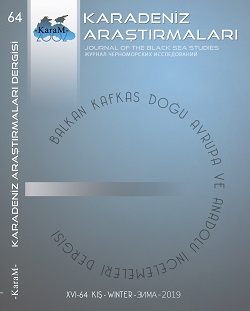Rus Kişiadbiliminde Yeni Bir Adlandırma Sistemi: Sovyet Ekolü
A New Naming System in Russian Antroponymy: The Soviet Ecole
Author(s): Şekip AktaySubject(s): Political history, Morphology, Lexis, Semantics, Eastern Slavic Languages, Pre-WW I & WW I (1900 -1919)
Published by: Karadeniz Araştırmaları Merkezi
Keywords: Russian antroponyms; Soviet Period personal names; Antroponymy; Name-giving in Russian;
Summary/Abstract: Having appeared in ancient eras, personal names are significant cultural codes which reflect the traditions and national-cultural values of the communities. These names, giving some clues about the life style of a nation, provide us with an idea about religious and political views of that community. Each nation has its own typical naming tradition. This tradition has developed in a different direction in Russia in comparison with Turkic customs. Except individual exceptions, all official Russian personal names are based on church Slavic canon, so they have Byzantium-Ancient Greek origins. Till the end of the 19th century, given names to the new-born babies were determined within the frame of Orthodox church canon. In 1905 the church started to lose its privilege. Limitation for name-giving was removed with the October Revolution (1917). Right after socialist regime was actualized in the country, the names to be given to the Soviet citizens were requested to be exactly new and convenient to the official ideology, so the government took important steps in this direction. Following the revolution, the duration between 1920s and 1930s was a new period in which a great number of newly-derived and lexically-borrowed personal names entered Russian vocabulary. In this paper, it is aimed to study historical, thematic, semantical and morphological aspects of these new personal names specific to the Soviets.
Journal: Karadeniz Araştırmaları
- Issue Year: 2019
- Issue No: 64
- Page Range: 629-645
- Page Count: 17
- Language: Turkish

